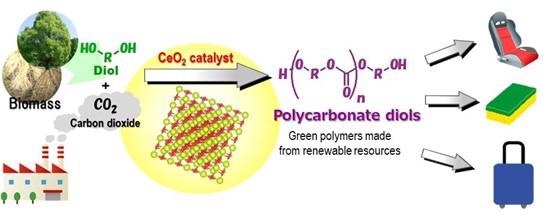An effective catalytic process has been developed by scientists using a CeO2 catalyst for the direct synthesis of polycarbonate diols without requiring dehydrating agents.
 CeO2 catalyzes the direct polymerization of flow CO2 and diols to provide polycarbonate diols in high yields, which are useful chemicals for polyesters, polyurethanes, and acrylic resins. Image Credit: Osaka City University.
CeO2 catalyzes the direct polymerization of flow CO2 and diols to provide polycarbonate diols in high yields, which are useful chemicals for polyesters, polyurethanes, and acrylic resins. Image Credit: Osaka City University.
Carbon dioxide (CO2) exhibits a high yield and highly selective process, which has blown it at atmospheric pressure to evaporate surplus water by-product. This enables for a catalytic process that can be utilized with any substrate with a higher boiling point compared to water.
Research Outline
Integration of a CeO2 catalyst with atmospheric carbon dioxide has enabled researchers from Osaka City University (OCU) to develop an efficient catalytic process for the direct synthesis of polycarbonate diols without making use of dehydrating agents.
This was done in collaboration with scientists from Tohoku University and Nippon Steel Corporation.
The new technique does not depend on deadly chemical feedstock such as carbon monoxide and phosgene, making it the first high yield “green” reaction system in the world. Their study was published in the Green Chemistry journal.
There is a global need to decrease CO2, which is considered to be one of the major greenhouse gases, and transforming it into a valuable chemical compound has gained huge interest in recent times. Although numerous effective catalyst systems have been developed, they depend on hazardous chemicals that produce by-products that are uncontrollable.
The processes executed using substrates that are safe and readily available, including water as the only by-product, have turned out to be a good alternative. Yet still, high levels of water by-products tend to hamper these processes from synthesizing adequate polycarbonates.
Most processes use a dehydrating agent to keep water levels low to overcome an equilibrium. But some of the issues to address are the high pressure of carbon dioxide needed, the recovery and regeneration of the dehydrating agent, and contamination of by-products generated by its use.
Masazumi Tamura, Study Author, Osaka City University
For these problems to be solved, a catalytic process was developed by the researchers that do not make use of a dehydrating agent. By concentrating on the variance in boiling points between the chemical product/diol and water, they anticipated a high yield of carbon fixation by blowing in CO2 at atmospheric pressure to evaporate surplus water.
It became clear that among the metal oxide catalysts we used. CeO2 showed the highest activity.
Keiichi Tomishige, Study Author, Tohoku University
This easy catalytic reaction system is the first one to be successful in synthesizing polycarbonate diols from carbon dioxide and diols at atmospheric pressure.
This process, without the need of dehydrating agents, can chemically convert carbon dioxide using any substrate with a boiling point sufficiently higher than water and can be applied to the synthesis of carbonates, carbamates, and ureas, which are useful additives for lithium-ion batteries and/or raw materials for polymer synthesis.
Kenji Nakao, Nippon Steel Corporation
This study was performed based on the results obtained from a New Energy and Industrial Technology Development Organization (NEDO) and Feasibility Study Program (Uncharted Territory Challenge 2050).
Journal Reference:
Gu, Y., et al. (2021) Direct synthesis of polycarbonate diols from atmospheric flow CO2 and diols without using dehydrating agents. Green Chemistry. doi.org/10.1039/D1GC01172C.